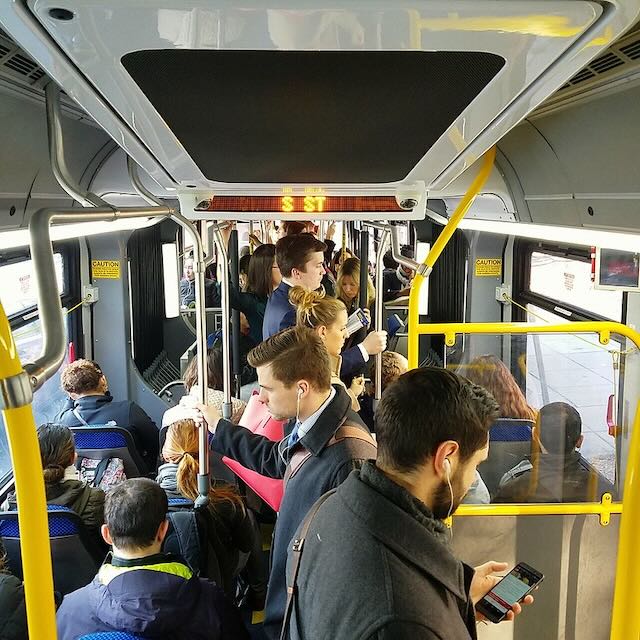MIT researchers are astounded to discover that the increase in telecommuting has changed how people travel. Their actual research paper is paywalled, but judging from the news release they issued, they got the numbers wrong.
 Americans are 25 times more likely to commute by auto than by transit, but an image search for “commute to work” turns up mostly photos of transit riders. Photo by Oren Levine.
Americans are 25 times more likely to commute by auto than by transit, but an image search for “commute to work” turns up mostly photos of transit riders. Photo by Oren Levine.
“A 1 percent decrease in onsite workers leads to a roughly 1 percent reduction in [automobile] vehicle miles driven, but a 2.3 percent reduction in mass transit ridership,” said one o the paper’s co-authors. Let’s check that.
Table B08301 of the American Community Service found that about 136 million Americans commuted to work in 2022 (total workers minute the number who worked from home), down from 148 million in 2019. That’s an 8.0 percent decline. It turns out the number of people who went to work by auto also declined by 8 percent, while the number who used transit fell by 36 percent. While the 8 percent number correlates with the MIT assertion that a 1 percent decrease in onsite workers correlates with a 1 percent reduction in auto use, the numbers indicate that a 1 percent reduction in onsite workers led to a 4.5 percent decrease in transit commuting.
But auto commuting is not the same as vehicle miles driven and transit commuting is not the same as transit ridership. The Federal Highway Administration’s Traffic Volume Trends indicate that Americans drove 2.0 percent fewer miles in 2022 than in 2019, so an 1 percent decrease in onsite workers results in only a 0.25 percent decrease in driving, just a quarter of what MIT found. Meanwhile, the Federal Transit Administration’s National Transit Database indicate that transit ridership in calendar year 2022 was 37.5 percent lower than in 2019. Thus, each percentage point decline in onsite workers correlated to a 4.7 percent decline in transit ridership, more than twice what MIT found.
How did MIT get it so wrong? I can think of several possibilities. One is that the researchers relied the American Community Survey commuting data, which appears to support their claim on auto usage but is a little different from their transit numbers, rather than actual driving and ridership data. In doing so, they might have failed to realize that not all travel is commuting and that a decrease in commuting doesn’t necessarily correlate with an equal decrease in travel. However, I doubt they made such a rookie mistake, partly because the American Community Survey isn’t cited in their references.
A second possibility is that they looked strictly at metropolitan area data and so failed to account for people moving in and out of such metro areas. Both the news release and the article abstract mention changes in metropolitan statistical area travel. One of the researchers also noted that the impact of remote work differs by metro area. Such a focus may have overlooked the increase in driving outside of those areas because so many people moved to rural areas.
The third and most likely possibility is that MIT used some source of data other than the American Community Survey, National Transit Database, and Traffic Volume Trends (though I don’t see any other sources of data on means of commuting cited in their references). If so, their results may differ but I don’t know why they wouldn’t use the best and latest data available.
In any case, the data we have indicate that MIT is right in general but wrong in particular. A 1 percent decline in onsite workers correlates to a 0.25 percent decline in miles of driving and a 4.7 percent decline in transit ridership. As I’ve been stressing since at least September 2020, politicians and transportation planners need to take these numbers into account before spending any more money and transportation infrastructure.








Apparently, the proponents of spending more money on transit infrastructure—no matter what!—are louder and more effective than the proponents of spending money wisely.
“How did MIT get it so wrong? I can think of several possibilities.”
Did you think of reading the actual paper instead of just guessing based off a news release summary?
I did and then, as it says in the first paragraph, I found out it was paywalled. I’m not going to pay $39.95 to read an article that tells me what I already know.
However, the abstract includes a list of all the references in the article so from that I can see the sources of their data. That reveals quite a lot about their methodology.
Remote work has no consequential effect on driving. Chain trips, allow accomplish same tasks on mileage.
If anything makes more driving because everything that has to be delivered to you. I summoned an Uber to go 3 miles.
He was 8 miles away.
can remote working end up having an effect on time of day congestion, bottlenecks, etc?
beware any paper that lists jim aloisi as an author, and if you shake hands, make sure you still have your rings, watch, and wallet